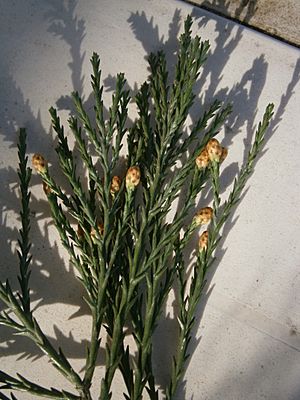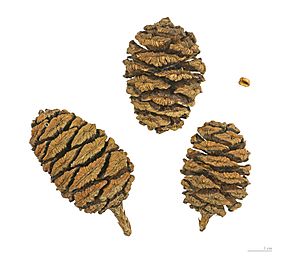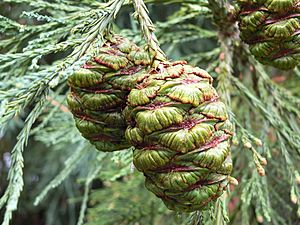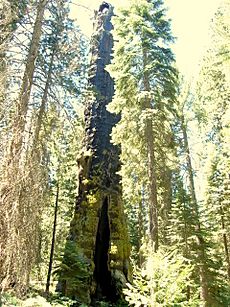Giant sequoia facts for kids
Quick facts for kids Giant sequoia |
|
|---|---|
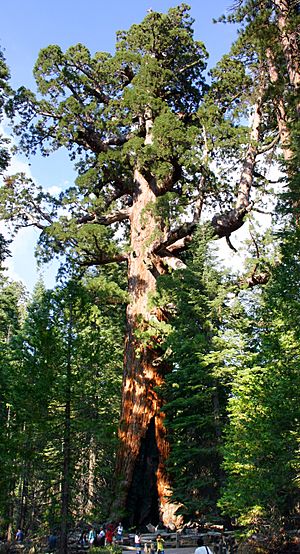 |
|
| The "Grizzly Giant" in the Mariposa Grove, Yosemite National Park | |
| Conservation status | |
| Scientific classification | |
| Genus: |
Sequoiadendron
|
| Species: |
giganteum
|
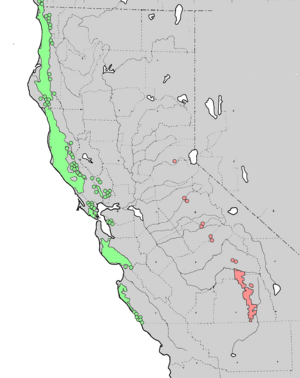 |
|
| Natural range of the California members of the subfamily Sequoioideae
red – Sequoiadendron giganteum
green – Sequoia sempervirens
|
|
The giant sequoia (scientific name: Sequoiadendron giganteum) is an amazing type of tree. It is also known as the giant redwood, Sierra redwood, or simply big tree. It is the only living species in its group, Sequoiadendron. Giant sequoias are one of three types of conifer trees called redwoods. They belong to the Cupressaceae family. The other two redwoods are the coast redwood and the dawn redwood.
Giant sequoias are the most massive individual trees on Earth. They naturally grow only in special areas called groves. These groves are found on the western slopes of the Sierra Nevada Mountains in California.
The name Sequoia might honor Sequoyah (1767–1843). He invented the Cherokee syllabary, a writing system for the Cherokee language. Some studies suggest the name also comes from the Latin word sequi, meaning 'to follow'. This is because the number of seeds in the cones of this tree follows a mathematical pattern with other related trees.
Contents
What Do Giant Sequoias Look Like?
Giant sequoias are the biggest trees in the world by total volume. They usually grow to be about 160 to 280 feet (50 to 85 meters) tall. Their trunks can be 20 to 26 feet (6 to 8 meters) wide. The tallest giant sequoia ever measured was 311 feet (94.8 meters) tall. The widest trunk belongs to the General Grant tree, which is 29 feet (8.8 meters) across.
The oldest known giant sequoia is over 3,200 years old. This makes them some of the oldest living things on Earth. Their bark is thick and rough, up to 3 feet (90 cm) thick at the base. This bark contains a special acid called tannic acid. It helps protect the tree from fire damage.
Giant sequoia leaves are always green. They are shaped like an awl, about 0.1 to 0.2 inches (3 to 6 mm) long. They grow in a spiral pattern around the branches.
How Do Giant Sequoias Reproduce?
Giant sequoias grow from seeds. Their cones are 1.5 to 2.7 inches (4 to 7 cm) long. They take about 18 to 20 months to become fully grown. However, they can stay green and closed for up to 20 years! Each cone has 30 to 50 scales, and each scale holds several seeds. On average, one cone has about 230 seeds.
The seeds are dark brown, about 0.1 to 0.2 inches (4 to 5 mm) long. They have a small, yellow-brown wing on each side. Some seeds fall out when the cones dry in hot weather. Most seeds are released when insects damage the cones or when fire dries them out. Young trees start making cones after about 12 years.
A large giant sequoia can have as many as 11,000 cones. It can release 300,000 to 400,000 seeds every year. The winged seeds can fly up to 590 feet (180 meters) away from the parent tree.
Where Do Giant Sequoias Grow?
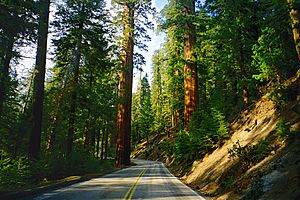
Natural Homes of Giant Sequoias
Giant sequoias only grow naturally in a small part of the western Sierra Nevada in California. They are found in scattered groups called groves. There are 68 known groves, covering only about 55 square miles (144 square kilometers). They don't grow everywhere in these areas, but in specific spots.
Most groves are protected in places like Sequoia National Park, Kings Canyon National Park, and Giant Sequoia National Monument.
Giant sequoias prefer a humid climate with dry summers and snowy winters. They usually grow on granite-based soils. In the northern parts of their range, they are found at elevations of 4,600 to 6,600 feet (1,400 to 2,000 meters). In the south, they grow higher, from 5,600 to 7,050 feet (1,700 to 2,150 meters).
Giant Sequoias Planted by People
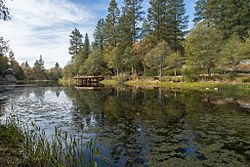
Sometimes, giant sequoias are planted in new areas. In 1974, the United States Forest Service planted some in the San Jacinto Mountains in Southern California. This was after a wildfire left the land empty. These trees were found again in 2008. The Black Mountain Grove now has over 150 giant sequoias, some over 20 feet (6.1 meters) tall.
What's special about these trees is that they are reproducing on their own. The conditions in the San Jacinto Mountains are similar to the Sierra Nevada, allowing the trees to grow naturally.
How Do Giant Sequoias Survive?
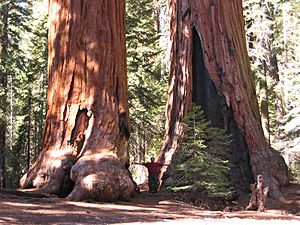
Giant sequoias are very good at surviving wildfires. Their bark is extremely fire resistant. Their cones usually open right after a fire, releasing seeds. These seeds need full sunlight and mineral-rich soil to grow well. They also need the ground to be clear of other plants.
Fires help by clearing out competing plants and preparing the soil. Without fire, other plants that like shade would grow too much. This would stop young sequoia seedlings from growing. Fires also create hot air that rises into the tree canopy. This heat dries and opens the cones, releasing many seeds at the perfect time.
In the past, people tried to stop all forest fires. This caused problems for giant sequoias. Without small fires, too much dry material built up on the ground. Other fire-sensitive trees, like white fir, grew too close to the sequoias. This made later fires much more intense and dangerous for the big trees.
Since 1970, the National Park Service has been doing controlled burns. They also let natural fires burn when it's safe. This helps the giant sequoias stay healthy.
Besides fire, some animals help spread sequoia seeds. A type of longhorn beetle lays eggs on the cones. The larvae bore holes, which helps the cones dry out and open. Douglas squirrels also chew on young cones. As they eat, some seeds fall to the ground.
Who Discovered and Named the Giant Sequoia?
Native American tribes living in the area knew about giant sequoias for a long time. They had names for the trees, like wawona and toos-pung-ish.
The first European to write about the giant sequoia was J. K. Leonard in 1833. His notes were not widely shared. In 1852, Augustus T. Dowd "discovered" the Calaveras Grove. This discovery became very famous. The tree Dowd found, called the 'Discovery Tree', was cut down in 1853.
Scientists then tried to give the tree a proper name. In 1853, John Lindley named it Wellingtonia gigantea. But this name was already used for another plant. Then, Joseph Decaisne tried to name it Sequoia gigantea, but this name was also already used for the coast redwood.
Finally, in 1939, John Theodore Buchholz gave it the correct scientific name: Sequoiadendron giganteum. He showed that the giant sequoia was different enough from the coast redwood to be in its own group.
John Muir, a famous naturalist, wrote about giant sequoias around 1870. He called them "King Sequoia" and described them as the "greatest light in the woods."
How Are Giant Sequoias Used?
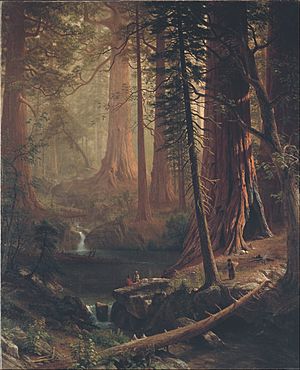
The wood from mature giant sequoias is very resistant to rot. However, it is also fibrous and brittle. This means it breaks easily, so it's not good for building. From the 1880s to the 1920s, people tried to cut down these trees for wood. But because the trees were so heavy and brittle, they often shattered when they fell. This wasted a lot of wood.
The wood was mostly used for things like roof shingles, fence posts, or even matchsticks. People were upset to see these huge, majestic trees used for such small purposes. This public outcry helped lead to most of the groves being protected. Today, you can visit Big Stump Grove to see how much wood was wasted.
Today, the main uses for giant sequoias are tourism and growing them as ornamental trees in gardens. Some people are also trying to grow younger giant sequoias on farms for timber. The wood from younger trees is less brittle and might be useful.
Growing Giant Sequoias Around the World
Giant sequoias are popular ornamental trees. They grow well in many places, including parts of Europe, the Pacific Northwest of North America, Australia, New Zealand, and Chile. They can handle cold temperatures down to -25°F (-31°C) if their roots are protected by snow or mulch.
There are different types of cultivated giant sequoias. Some have blue leaves, some are more compact, and some have weeping branches.
Giant Sequoias in France
The tallest giant sequoia outside the United States is in France. It was planted near Ribeauvillé in 1856. In 2014, it was measured at about 190 feet (58 meters) tall. It was 158 years old at that time.
Giant Sequoias in the United Kingdom
Giant sequoia seeds first arrived in Britain in 1853. They were sent by a botanist from California. These seeds were then widely planted across Europe.
Giant sequoias grow very fast in Britain. The tallest one, at Benmore Botanic Garden in Scotland, was 185 feet (56.4 meters) tall in 2014. It was 150 years old. Many others are over 160 feet (50 meters) tall. The widest one is about 39 feet (12 meters) around its trunk.
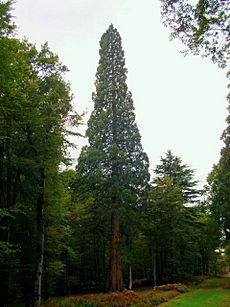
The Royal Horticultural Society has given Sequoiadendron giganteum a special award for garden plants.
In 1865, an avenue of 218 giant sequoias was planted near Camberley, England. These trees are now surrounded by modern buildings.
Giant Sequoias in Italy
Many giant sequoias were planted in Italy between 1860 and 1905. Several trees are now 130 to 157 feet (40 to 48 meters) tall. The largest tree in Italy is in Roccavione. Its base is about 52 feet (16 meters) around. One famous tree survived a 650-foot (200-meter) tall flood wave in 1963!
Some young trees in Italy have grown very quickly. One reached 72 feet (22 meters) tall and 35 inches (88 cm) wide in just 17 years.
Giant Sequoias in Northern and Central Europe
Further north in Europe, cold winters can limit growth. In Denmark, where temperatures can drop to -32°C (-25°F), the largest tree was 115 feet (35 meters) tall in 1976 and is even bigger now. One tree in Poland is said to have survived temperatures as low as -37°C (-35°F) with heavy snow.
In Serbia, 29 giant sequoias grow in Belgrade's Lazarevac area. They are about 98 feet (30 meters) tall. The oldest sequoia in the Czech Republic is 144 feet (44 meters) tall. It grows in the Ratměřice castle garden.
Giant Sequoias in the United States and Canada
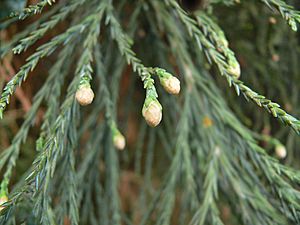
Giant sequoias grow very well in the Pacific Northwest of North America. This includes western Oregon and southwest British Columbia. In cities like Seattle and Tacoma, it's common to see large sequoias over 90 feet (27 meters) tall in parks and yards.
In the northeastern US, they grow more slowly. They can also get fungal diseases because of the hot, humid summers. A tree in Bristol, Rhode Island, is 89 feet (27 meters) tall, making it the tallest in New England. Another in Delaware County, Pennsylvania, is 95 feet (29.1 meters) tall.
A special type of giant sequoia called 'Hazel Smith' was chosen in 1960. It is more tolerant to cold and grows better in the northeastern US.
Giant Sequoias in Australia
The Ballarat Botanical Gardens in Australia have many giant sequoias, some about 150 years old. You can also find specimens in Daylesford, Orange, New South Wales, and Carisbrook. Two trees planted in the 1860s are in Jamieson Township.
In Tasmania, sequoias are found in private and public gardens. The Westbury Village Green and Deloraine have mature trees. The Tasmanian Arboretum has both giant sequoias and coast redwoods.
The Pialligo Redwood Forest near Canberra International Airport has 3,000 surviving redwood trees. The National Arboretum Canberra started a new grove of giant sequoias in 2008.
Giant Sequoias in New Zealand
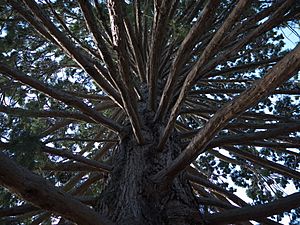
Several impressive giant sequoias grow in the South Island of New Zealand. There are trees in parks in Picton, Christchurch, and Queenstown. Some are also in private gardens in Wanaka.
In Christchurch, there are mature trees at the Riccarton Park Racecourse. The suburb of ‘Redwood’ is even named after a 160-year-old giant redwood tree. A grove of about sixteen redwoods is in Sheldon Park in Belfast, New Zealand.
A very large tree at Rangiora High School was planted for Queen Victoria's Golden Jubilee. It is now over 130 years old.
Rotorua's Redwoods
The best place to see giant redwoods in New Zealand is at Rotorua. The six-hectare Redwood Memorial Grove is protected. These trees were planted in the early 1900s to see if they could be grown for timber in New Zealand.
Hanmer's Redwoods
A number of mature redwood trees grow in the center of Hanmer township in North Canterbury.
Amazing Giant Sequoia Records
Some sequoias that were cut down in the past, like the Mother of the Forest, were likely much larger than any living tree today. Here are some records for living giant sequoias:
Largest by Trunk Volume
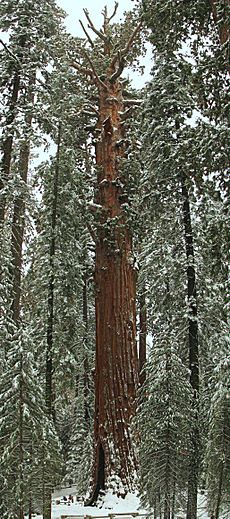
As of 2009, these are the top ten largest giant sequoias by the volume of their trunks:
| Rank | Tree Name | Grove | Height (m) | Girth at ground (m) | Volume (m3) | Estimated Age (years) |
|---|---|---|---|---|---|---|
| 1 | General Sherman | Giant Forest | 83.8 | 31.4 | 1489 | 2,300−2,700 |
| 2 | General Grant | General Grant Grove | 81.7 | 32.9 | 1320 | 1,650 |
| 3 | President | Giant Forest | 73.5 | 28.3 | 1288 | 3,200 |
| 4 | Lincoln | Giant Forest | 78.0 | 29.9 | 1260 | |
| 5 | Stagg | Alder Creek Grove | 74.1 | 33.2 | 1205 | 3,000 |
| 6 | Boole | Converse Basin | 82.0 | 34.4 | 1202 | 2,000 (minimum) |
| 7 | Genesis | Mountain Home Grove | 77.1 | 25.9 | 1186 | |
| 8 | Franklin | Giant Forest | 68.3 | 29.0 | 1169 | |
| 9 | King Arthur | Garfield Grove | 82.3 | 31.7 | 1151 | |
| 10 | Monroe | Giant Forest | 75.6 | 27.7 | 1136 |
- The General Sherman tree is estimated to weigh about 2,100 tonnes.
- The Washington Tree used to be the second largest. But after a fire in 2003 and a snowstorm in 2005, it lost much of its trunk.
Tallest Giant Sequoias
- Redwood – Redwood Mountain Grove – 94.8 meters (311 feet)
- Tallest outside the United States: near Ribeauvillé, France, 58 meters (190 feet) in 2014.
- Tallest planted outside its natural range: in Oregon, US, 65 meters (213 feet) in 2020.
Oldest Giant Sequoias
- Muir Snag – Converse Basin Grove – more than 3,500 years old.
Widest Giant Sequoias
- Waterfall Tree – Alder Creek Grove – 47.2 meters (155 feet) around its base.
- Tunnel Tree – Atwell Mill Grove – 17.4 meters (57 feet) wide at its base.
Biggest Branches and Bark
- Largest limb: Arm Tree – Atwell Mill Grove – 4 meters (13 feet) in diameter.
- Thickest bark: 0.9 meters (3 feet) or more.
Images for kids
See also
 In Spanish: Secuoya gigante para niños
In Spanish: Secuoya gigante para niños




